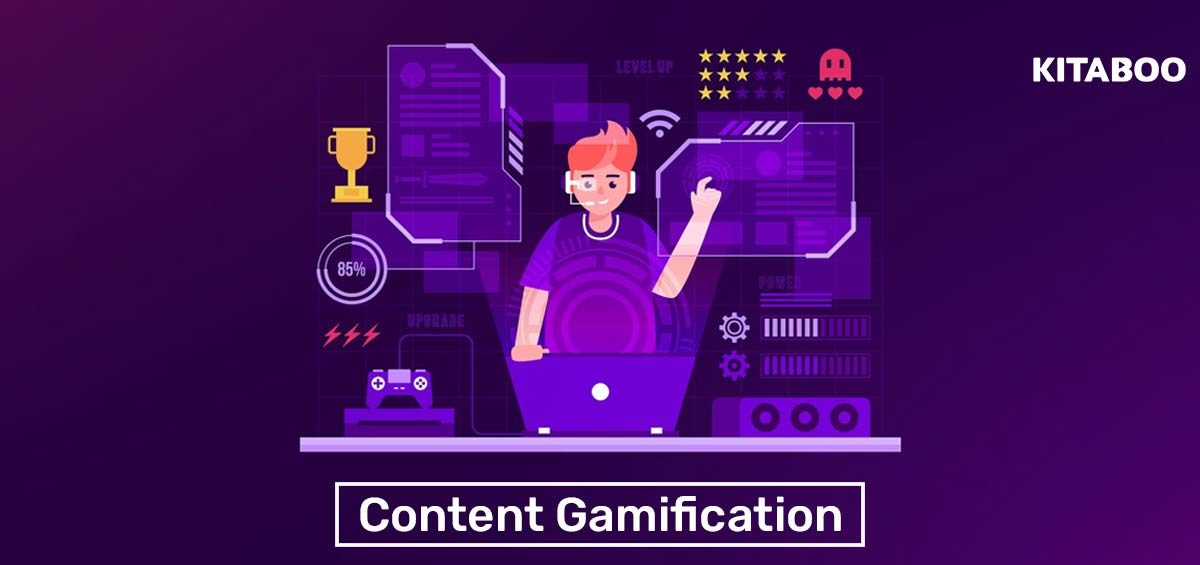If you come from the traditional prism of thinking, gaming and learning may seem like the opposite ends of a spectrum. However, in times of digital learning, gamification and education have become two sides of the same coin and play a major role in enhancing student engagement and effective learning processes.
Content gamification is the principle of applying game mechanisms or adding rewards, goals, and other engaging elements to motivate students. Due to its many benefits, gamification in learning is expected to grow by an average of 27.9% every year between now and 2032, projected to reach around USD 116.68 billion.
If you are looking for ways to make your learning content more engaging and effective, Content gamification is a great option to consider. This blog will explore how to gamify your content and tips for creating effective modules using your existing materials.
Table of Contents
I. What is Content Gamification?
II. How Can Gamification Be Used in Education?
- Improve Content Engagement
- Track Student Progress
- Improve Learning Outcomes
- Creates Timelines or Plans
III. What are the Benefits of Content Gamification?
What is Content Gamification?
Content gamification is the addition of game-like elements in educational content, which can improve engagement and make the learning journey more interactive. Adding these gamified elements motivates students to complete daily activities for points, badges, or other benefits.
Gamified elements, like introducing rewards, challenges, storylines, and competitions, are actively used in education and corporate training. As per a recent study, gamified content helped improve student performance by 89.45% compared to lecture-based education and has proven to improve student retention and attention in a particular subject.
How Can Gamification Be Used in Education?
In education, content gamification can make learning more fun and engaging and help students achieve their learning goals. Here are a few ways it can be used in the education sector:
Improve Content Engagement
The success of gamification lies in making the content interactive and lively. This includes using interactive videos, live demonstrations, or other mechanisms to help convert learning content into interactive gamified elements.
With advanced AI-powered assistants like K.AI, teachers can easily convert their existing content into interactive MCQs and flashcards and even use them to create chapter summaries. This enables students to leverage the power of interactive learning and improves overall retention and engagement.
Track Student Progress
Students can progress through each class or lesson by adding gamified elements like quizzes or challenges and completing these activities to gain points or badges. While this is rewarding for the students, teachers and educators can use this to understand students’ progress, identify gaps, and assess their understanding of a particular subject.
Improve Learning Outcomes
Gamification has been shown to improve learning outcomes in a variety of studies. Since gamified content helps keep students engaged and motivated, it can enhance their overall performance and learning outcomes.
Creates Timelines or Plans
Gamification also helps create a sense of timeliness for students, as they get points to complete tasks in a stipulated timeline. When students know the benefits of completing an assignment or lesson, they are more likely to stay on track and complete their course within the expected timelines. Educators can also add levels or checkpoints to help students understand their progression and help them stay motivated.
What are the Benefits of Content Gamification?
Some of the benefits of content gamification include
Stimulates the Mind
Content gamification is not just about improving the learning experience; it can also help influence student behavior through specific events or mechanisms.
Gamified learning helps improve the experience by triggering dopamine release due to specific events. For example, completing a challenge or a task to gain points motivates the student to continue learning and makes it enjoyable.
Improves Memory Recall
As students are more engaged, content gamification can lead to better retention of information. Using quizzes or challenges after every lesson, students can test their understanding of a particular subject or lesson, improving retention and long-term memory.
Helps Create Personalized Learning
Content gamification is usually paired with self-paced learning mechanisms. Students can choose their own challenges and rewards and chart their learning journey. This adaptive learning helps reduce boredom and improves student engagement.
Strategies for Content Gamification
Several strategies can be used to gamify educational content. However, the most common include the following:
Using Points & Reward Systems
Points and rewards are a simple but effective way to gamify content. Learners can earn points for completing tasks, answering questions correctly, or other behaviors. These points can be redeemed for rewards, such as badges, virtual items, or access to exclusive content.
Creating Levels or Challenges
Course creators can add levels or challenges at the end of a lesson to assess a student’s understanding of a particular subject. This can help learners track their progress and feel accomplished as they complete it. Each level can be progressively more difficult, providing learners with the right sense of challenge without being too overwhelming.
Badges
Who doesn’t enjoy having a badge or a trophy to showcase their accomplishment? In the virtual space, an object or badge can be pinned to the profile for a certain accomplishment. It motivates learners to strive for excellence and brings a competitive side to learning.
Leaderboards
Another way to bring out the competitive side in learning and motivate students to do their best is having a leaderboard. Leaderboards can show learners how they perform compared to their peers, and there can be multiple competitions to ensure a healthy mix of skills and learning.
While these are just some of the strategies you can consider for your content gamification, make sure it is tailored to your audience. Gamification should be fun and engaging, as learners are less likely to stick with it if it becomes too competitive or can even demotivate learners if not used effectively.
Also Read: Creating DRM Protected eBooks
The Final Word
Content gamification is undoubtedly the future of learning and will play a significant role as organizations adopt digital learning tools. However, it is essential to use gamification wisely and ensure that it is relevant to the content, adds to the learning journey, and is tailored to the audience.
Key Takeaways:
- Gamification can help learners stay engaged and motivated with the proper guidance and approach.
- Gamification should be combined with interactive and adaptive learning programs for better results. Instead of using it as a one-off replacement to traditional learning methods, it should be an addition.
- Gamification should be used in moderation, as too much of it can overwhelm students.
If you want to improve your content distribution and include interactive and gamified content elements, KITABOO is the ideal partner for your needs. KITABOO is one of the leading digital textbook platforms which can blend with your LMS, making publishing, distributing, and tracking learning content easy.
To know more about how we can help you create interactive and engaging content using your existing materials, write to us at KITABOO@hurix.com.
Suggested Reads:
Discover How An Ebook Conversion, Publishing & Distribution Platform Can Help You
Kitaboo is a cloud-based content platform to create-publish & securely distribute interactive mobile-ready ebooks.
You May Also Like








